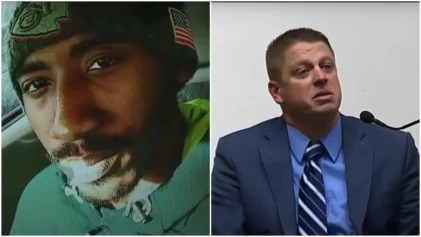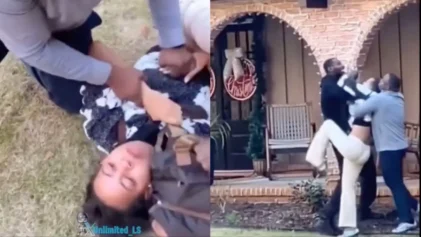More details have emerged over the last two days of Kim Potter’s manslaughter trial for the shooting death of Daunte Wright, a Black Minnesota motorist she and another officer stopped in a Minneapolis suburb on April 11 for having expired tags on his SUV.
Potter was yelling “Taser” when she fired the gunshot that killed the 20-year-old Wright, who police said said was attempting to flee after getting back into his vehicle when told there was outstanding warrant for his arrest.

One revelation on the witness stand this week was from a police sergeant who trained the department. He testified to the court that officers are taught not to stun someone if they are operating a vehicle.
Two ranked officers were brought on the stand on Tuesday, Dec. 14, and Wednesday, Dec. 15. The principal aim of their testimony was to shed light on the Brooklyn Center Police Department’s policy on using Tasers.
Brooklyn Center Police Commander Garrett Flesland took the stand and explained that the department started using Tasers almost 20 years ago in 2002. He noted that officers are taught to carry Tasers on their non-dominant side.
The commander then shares that there are two ways that officers are taught to holster their Tasers.
One way that they are trained to holster the weapon is called the “cross draw.” With the “cross draw,” it is easier to pull the device with your dominant hand. It also positions the instrument’s handle to the front of the officer’s body.
The other way officers are taught to holster a Taser is called the “reaction draw,” which is easier for your non-dominant hand to grab and has the handle pointing toward the back of the officer’s body.
Pictures shown by the prosecution revealed that Potter carried her Taser on her non-dominant side and holstered it in the reaction draw position.
This aligns with the recommendations of Arizona-based Axon Enterprise Inc, the company that manufactures Tasers. That company recommends that police “carry a Taser in a separate holster from their gun and on an officer’s non-dominant side, with the gun positioned on the dominant side.”
The police manual that Flesland says that officers learn from further states that Tasers must be “in a reaction-side holster on the side opposite the duty weapon” and that officers should be trained every year.
Documents presented to the courts by the prosecution showed that Potter was certified to use the Taser in 2002 and recertified in 2005, 2007, 2015, 2016, 2017, and 2019. Each time she was reviewed, she received a perfect score from her trainer. Despite having great scores, she was not trained annually.
Flesland further testified that the BCPD policy is clear that the use of a Taser should only be “to control a violent or potentially violent individual while minimizing the risk of serious injury.”
Sgt. Mike Peterson, the officer in charge of the instruction for BCPD, also testified on Tuesday.
He shared that during the training officers are told not to stun someone if they are operating a vehicle, which is in accordance with what the makers of Tasers suggest. The prosecution wasted no time and shared with the jury this particular warning from the weapon’s manufacturers.
The next day of the trial, WCCO reported that Flesland revealed during his cross-examination by the defense that he has known Potter for 20 years. He stated, “She’s a good cop, she’s a good person, she’s a friend.” The prosecution objected to this characterization but Judge Regina Chu allowed it.
Sgt. Peterson was also brought back to the stand for cross-examination.
He was asked by the defense his professional opinion about police confusing tasers for guns. The sergeant shared that he understood that “several” officers had made the mistake, but Potter was the only one that he knew in the department that had.
Potter’s defense attorney, Earl Gray, began his cross-examination of the prosecution’s use-of-force witness, University of South Carolina law professor Seth Stoughton, the same expert from the Derek Chauvin murder trial.
The expert said that Potter’s use of deadly force, “was not appropriate, and the evidence suggests” that her actions are not what most other officers would have chosen to do.
The defense continued to suggest that Potter had no choice but to respond how she did because she believed that had Wright driven away Sgt. Mychal Johnson, who was leaning into the passenger side of the vehicle, would have been dragged and injured.
Stoughton said in his opinion that was an unreasonable assumption. From looking at the video of the scenario, he believes that Johnson was not in imminent danger because he was on the outside of the car when Potter alerted Wright that she was going to use her Taser.
The expert also said that after hearing Potter say that she was going to go to jail, he believed that was her recognizing that she went too far with her use of force.
Stoughton further testified that he believed that a car that is not moving is not a threat and added that if a car is moving an officer should not shoot at it either. “If the use of deadly force is effective at best what you’ve created is a potential unguided hazard,” he opined.
When addressing the use of the Taser, he agreed that the weapon is “less lethal” than a gun, but still “inappropriate” because Wright was in the driver’s seat of the car.
He shared that if there was a threat that Wright posed, it was that he might escape. However, by this time in the engagement, Potter had already gotten his personal information like his address and could have arrested him later.
The defense shifts direction in their questioning. While unpacking Stoughton’s years of experience as an officer and what actually makes him an expert, Gray focused attention on what Stoughton charges the state for his services. The defense lawyer made public that the professor gets paid $295 an hour for his expert services per case, totaling a whopping $10,000 to date on this trial alone.
In an effort to paint the professor as anti-cop, the defense highlighted the nature of the cases that he gets paid for. He noted that Stoughton has served on almost 30 cases in his career that involve the state suing police officers
While the Taser debate was intriguing and shed light on the actions of that night, the prosecution wanted to shed light on events of many nights before. The prosecution called Daunte Wright’s father to the stand Wednesday to speak about his son.
A sobbing Aubrey Wright said that he had a “close relationship” with his son. He talked about Daunte being a dad to his own son, saying, “To see him as a father … I was so happy for him because he was so happy. He was so happy about Junior. It was my chance to be a grandfather.”
He finished his testimony saying, “I miss him a lot … every day.”
The defense chose not to cross-examine.
More news from our partners:
Two Friends Left Steady Paychecks, 401(k)s and Bet on Themselves. Today They Run a $1M Business.


